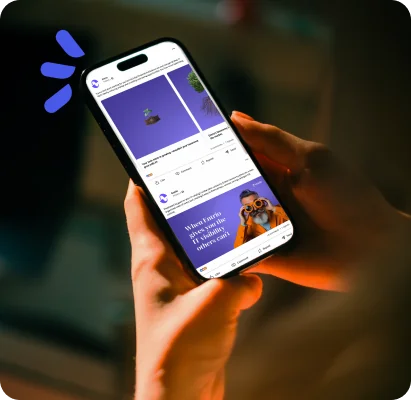
If you’ve ever tried to get the word out about your business, you know that running a marketing campaign is easier said than done.
As much as we wish it were simple, a campaign is so much more than picking a topic, creating a few content pieces, and hitting “publish.” There’s nuance, strategy—and a lot of moving parts.
Whether you're launching a new product or building thought leadership, Accelity follows a proven process to make every campaign strategic, impactful, and results-driven.
Pick one goal for your marketing campaign
You likely have several marketing goals—building brand awareness, increasing website traffic, and generating more demo requests. And while a strong campaign might touch more than one area, choosing one clear goal is essential.
When your team is aligned on a single outcome, every piece of content, every CTA, and every conversation moves in the same direction. It’s the difference between “doing marketing” and actually driving measurable results.
Let’s use lead generation as our example. If the goal is to generate more MQLs, we’ll first assess your current metrics and sales funnel to establish a baseline. Then, we’ll set a SMART goal—specific, measurable, achievable, realistic, and time-bound—to guide the campaign strategy.
This is just the first step. From here, we’ll walk through the full process—how we build your campaign, tailor it to the right audience, and create content that actually moves the needle.
1. Identify your audience
Although it’s tempting, casting a wide net isn’t the best way to reach your audience. You might generate more leads overall—but ask yourself, will they all be quality? Marketing to everyone is marketing to no one. The trick is knowing who actually needs to hear your message.
Together, we’ll narrow in on the right audience for your campaign. We’ll start by reviewing the buyer personas we built during onboarding to determine which ones align best with your goal. Maybe new legislation makes your product especially relevant for one persona. Or maybe it’s the off-season for another, and we’ll want to save that effort for later.
Our team creates content tailored to multiple personas with smart, strategic variations—so the right people get the right message at the right time. The audiences we choose won’t be random; they’ll be intentional and aligned with your campaign’s purpose.
Because we’ve already identified where each buyer persona prefers to engage (LinkedIn, email, etc.), we’ll use that knowledge to shape the campaign content and format. Your audience will guide every choice, from platform to message.
2. Create the content
Once the goal is set and your audience is locked in, it’s time to bring the campaign to life through content!
During the planning phase, we’ll use a campaign outline to determine how many pieces you need and what types will best support your brand’s goal.
Let’s say we’re running a lead gen campaign for two personas. Your content might look like this:
- One customer case study. A designed PDF highlighting a real client success story that shows how your solution solved a tangible problem. Your case study is easy to download, share, and forward to other decision-makers.
- Two search-optimized blogs. Each blog expands on the case study. Blog 1 could focus on pain points from the old solution (like the one your customer replaced), while Blog 2 explores why this challenge matters to your industry right now.
- Three emails per persona. Each email will introduce Blog 1, Blog 2, and the offer—helping prospects get to know your brand without feeling like they’re being sold to. Simply offering useful information.
- Three social posts per platform. Social extends your reach beyond your email list, pushing Blog 1, Blog 2, and the offer out into the wild to spark interest and drive clicks.
- Two LinkedIn ads. With budget in mind, we’ll use LinkedIn ads to make sure your case study gets in front of the right people.
- One traffic-driving article on an external site. To build credibility and thought leadership, we’ll help pitch and write a piece that links back to your site and supports the campaign.
The power of a campaign lies in the connections between the pieces. Each one adds another layer to the story we’re telling. And while prospects might only see one touchpoint—a blog, a social post, or an email—it’s built to stand strong on its own and guide them toward conversion. (But trust us: they’ll start noticing the whole picture.)
3. Measure the campaign’s performance
The best way to know if your campaign worked—aside from an anxiety (the good kind)-induced account manager and sales team—is to measure it against the metrics we set at the start (remember that SMART goal?).
But measurement isn’t just something we do at the end. We monitor campaign performance throughout its run and share updates with you along the way. By keeping an eye on real-time analytics, we can quickly pivot and make smart adjustments to ensure your content is resonating with your audience.
Let Accelity build your next marketing campaign
When you work with Accelity, you don’t just get marketing support—you get a dedicated team that’s all-in on your success.
From strategy to execution, we handle the heavy lifting. Our team knows how to build campaigns that not only look good, but actually perform—rooted in data, tailored to your audience, and aligned with your goals.
If you’re ready for marketing that drives results (and maybe even makes your sales team a little busier than usual), let’s shake on it. Connect with us today.
Subscribe to our newsletter
Curated content, news articles, team updates and more.



